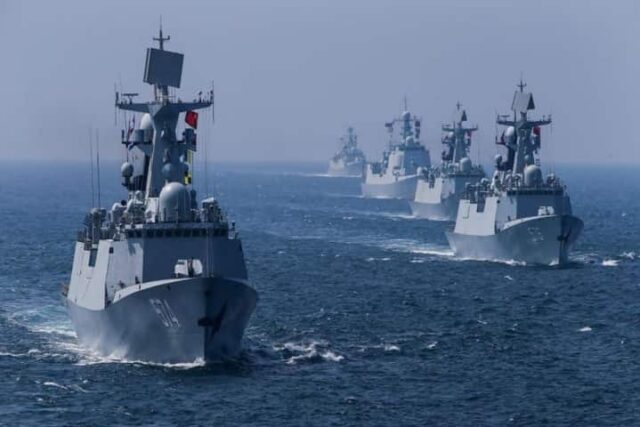The Eastern Indian Ocean (EIO) is witnessing the increasing military presence of China. Two recent developments are significant in this regard: first, China’s People’s Liberation Army Navy (PLAN) has recently conducted maiden naval exercises with Cambodia.
It points to the strengthening of China-Cambodia defence ties. Moreover, China is upgrading and modernizing the infrastructure at the port of Ream in Cambodia, located on the Gulf of Thailand. As per reports, it includes a new command centre, meeting and dining halls, as well as medical outposts. A dry dock, slipway, and two new piers will also be constructed. China will also undertake dredging to prepare the port for hosting larger vessels, presumably naval warships. China is deeply invested in Cambodia, including through the Belt and Road Initiative (BRI) and the foothold at Ream will increase Beijing’s ability to project power in maritime Southeast Asia.
The second important development involves the likelihood of China developing military facilities on the Great Coco Islands of Myanmar. Taken together, India’s China challenge is set to intensify in the EIO.
The EIO is at the heart of the Indo-Pacific region. It links the Western Indian Ocean with the Western Pacific Ocean. The countries of Southeast Asia and Australia are located along the EIO. The sea lanes passing through the EIO facilitate trade as well as naval presence of East Asian countries including China in the wider Indian Ocean region. The Strait of Malacca, Sunda, Makassar and Lombok are becoming increasingly important in this regard. In fact, for the last two decades, China has remained worried about the ‘Malacca Dilemma’ as the majority of its energy imports passes through the strategically located waterway. It fears that hostile powers will cut off its access to the strait of Malacca and will be able to put pressure. Therefore, Beijing has vehemently objected to India’s plans to develop the port of Sabang in Indonesia. It worries that the foothold at Sabang and the strategic position of India’s Andaman and Nicobar Islands, where New Delhi is fast-developing military infrastructure, near the Strait of Malacca will worsen the situation for China.
As a result, China has been frantically making efforts to overcome the ‘Malacca Dilemma’. Overland energy pipelines via Central Asia and Russia are aimed at alleviating this problem. Moreover, the China-Pakistan Economic Corridor (CPEC) and China-Myanmar Economic Corridor (CMEC) also include the network of energy pipelines that will help reduce the dependence on the strait of Malacca. These pipelines will directly bring supplies to mainland China. CMEC is more critical in this regard as it connects Yunnan province in southern China to the Bay of Bengal. The problem of dependence on the Strait of Malacca provides a strategic rationale behind China’s attempts to increase and regularize its maritime military presence in the EIO. It seeks to ensure the security of its energy supply. In addition, China, with its rapidly growing naval fleet, feels confident enough to venture into the Indian Ocean and familiarize itself with the complex operating environment. The regular naval forays far away from the shores also help in training crews for longer-range deployments.
The intensification of military ties with Cambodia and Myanmar serves China’s multiple interests. First, for China, the regular naval exercises, military supplies and port visits along with the access to strategically important locations like the Great Coco Island and Ream naval base will help deepen the already close military-to-military ties with Myanmar and Cambodia. These two countries are acutely dependent on Chinese economic, diplomatic and military support. In the wake of the military coup in Myanmar, the regime finds itself globally isolated and therefore, just like in the 1990s, China’s influence is steadily growing in Myanmar. Cambodia’s ties with the U.S. have soured. At Ream, Cambodia has demolished the structures built by the U.S. and even refused to allow Washington to repair the port facilities. In the vacuum, China has entered.
Second, the strategic location of these countries will be useful for China to establish a firm foothold in the EIO. The foothold in Cambodia and Myanmar will help Beijing keep a careful watch on the strategic activities of India in the region. It could monitor India’s expanding naval movements in the EIO more closely and track missile tests conducted in the Bay of Bengal. In fact, there were rumours that in the 1990s, China had established a tracking facility at the Great Coco Islands in Myanmar for precisely this purpose. A foothold in Myanmar and Cambodia will increase the strategic reach and presence of the PLAN. With the network of bases from East Africa (Djibouti), South Asia (Gwadar in Pakistan) to Southeast Asia (Ream in Cambodia), PLAN will be able to stay longer in the Indian Ocean and protect the interests of China.
Third, burgeoning ties with these two poor, authoritarian and globally isolated countries help Beijing to break the unity of ASEAN countries and sow discord over the issue of maritime disputes in the South China Sea. It weakens the resolve of Southeast Asian countries and countries like Vietnam and the Philippines that are locked in a dispute with China in the South China Sea. Sensing this, the Philippines is deepening its military ties with the United States. The recent agreement to allow the U.S. access to four more bases in the Philippines and the decision to purchase BrahMos cruise missiles from India have to be seen in this context.
Beijing’s steadily expanding strategic activities in the EIO will further worsen India’s China challenge. The role of Andaman and Nicobar Islands in India’s Indo-Pacific strategy has never been as important as it has become now.
(This article appeared first on indianarrative.com. Sankalp Gurjar is Assistant Professor at the Department of Geopolitics and International Relations, Manipal Academy of Higher Education, Udupi, India. He is the author of ‘The Superpowers’ Playground: Djibouti and Geopolitics in the Indo-Pacific in the 21st Century’.)
















